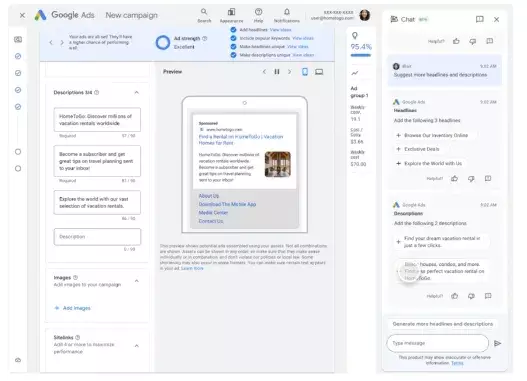In a pivotal moment for digital advertising, Google recently revealed an array of artificial intelligence (AI) enhancements for Google Ads during its presentation at DMEXCO, one of the premier digital marketing conferences in Europe. These innovations come as a response to the increasing demand for more sophisticated digital marketing tools that can drive better results for businesses. With functionalities ranging from advanced AI creation assistance to more granular control over ad parameters, Google is aiming to revolutionize how ads are created, managed, and optimized.
Central to Google’s latest offerings is the expansion of its AI-driven ad building capabilities across various languages. Initially launched in English, Google’s AI tools have greatly simplified the ad creation process, allowing advertisers to merely submit a landing page URL, after which the AI can generate descriptions, relevant keywords, and even images tailored to the business. This groundbreaking feature is set to extend its language support to German, French, and Spanish in the near future, thereby increasing accessibility for advertisers operating in multilingual environments. By enhancing language capabilities, Google aims to empower a broader range of advertisers, catering to various markets while ensuring effective messaging.
A notable enhancement is Google’s introduction of its AI image editing capabilities across all campaign formats, moving beyond the current singular focus on Performance Max ads. This change enables businesses to leverage AI-driven image customization tools across multiple campaign types—Search, Demand Generation, Application Ads, and Display—effectively elevating the quality of their visual content. Moreover, the transition to offering visual asset generation tools in additional languages—like Portuguese, Dutch, and Italian—illustrates Google’s commitment to serving an extensive demographic of global advertisers.
Another notable development from Google is the improvement in its brand guidelines for Performance Max campaigns. Advertisers will now gain increased control over the assets generated by AI. This feature is vital for maintaining brand consistency while maximizing creativity. Enhanced feedback tools are being introduced as well, designed to help advertisers refine their campaigns. Starting next month, the new asset coverage reporting will allow advertisers to identify underperforming groups and obtain specific recommendations for optimization. This provides actionable insights that can significantly enhance campaign performance.
In an attempt to streamline advertising efforts further, Google is now adding campaign-level negative keywords within Performance Max campaigns. This feature allows advertisers to better manage which search terms will not trigger their ads, thus enhancing targeting efficiency. Additionally, the rollout of omnichannel bidding for Demand Generation campaigns demonstrates Google’s aim to unify the bidding strategy across various channels. By enabling advertisers to utilize a cohesive bidding approach, Google is significantly simplifying the complexities often involved in managing multiple advertising platforms.
The myriad updates reflect Google’s understanding of the unique challenges modern advertisers face. As the landscape of digital advertising continues to evolve, leveraging AI presents compelling advantages for performance optimization. The image generation capabilities could bridge the gap between creative intent and market needs by tailoring ad visuals based on performance data, a shift that could prove invaluable. Unlike image generation in social applications, Google’s offerings are designed with the specific aim of improving advertising outcomes, showcasing the practical utility of AI in enhancing brand visibility and engagement.
As AI technology continues to mature, Google’s latest updates for Google Ads symbolize a strategic step towards maximizing the effectiveness of digital marketing campaigns. With powerful tools designed to improve accessibility, customization, and performance analytics, advertisers are now better equipped to navigate the complexities of reaching their target audiences. In an environment where competition is fierce, leveraging these innovations could be the key to gaining a competitive edge and unlocking new growth opportunities. By embracing such advanced tools, brands can look forward to a future of advertising that is not only more efficient but also more creative and data-driven.


Leave a Reply